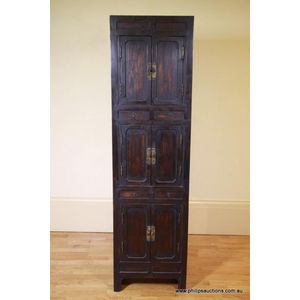French Walnut Display Cabinet with Carved Details
You must be a subscriber, and be logged in to view price and dealer details.
Subscribe Now to view actual auction price for this item
When you subscribe, you have the option of setting the currency in which to display prices to $Au, $US, $NZ or Stg.
- Cornice - The upper section of a high piece of furniture such as a bookcase, wardrobe or cabinet that sits immediately on the main structure. The cornice is usually decorated with a variety of architectural mouldings, worked either with a moulding plane or, from the later 19th century, by machine. The front and side of the cornice are mitred together, strengthened by glue blocks, and the back is generally a simple dovetailed rail to hold the structure together. Cornices are generally, though not always, fitted separately to the piece and are held in place either by screws sunk into the top board or by wooden corner blocks. A pediment may sit above the cornice, but sometimes the terms cornice and pediment are used interchangeably.
- Circa - A Latin term meaning 'about', often used in the antique trade to give an approximate date for the piece, usually considered to be five years on either side of the circa year. Thus, circa 1900 means the piece was made about 1900, probably between 1895 and 1905. The expression is sometimes abbreviated to c.1900.
- Bow Front - The front is shaped in a gentle curve or bow. Introduced during the 18th century, the bow-front is associated with furniture of the Hepplewhite and Sheraton period, though of course the form continued to be used throughout the 19th century. Bow-fronted pieces are usually veneered, although some were cut from the solid wood. Where veneer is used, the carcase is cut either from pine or deal, or sometimes the front was built up and shaped with small timber 'bricks'. Commonly used on various types of furniture including chairs, settees, chests, side tables, sideboards and display cabinets.
- Apron - A decorative wooden panel that sits underneath the top surface of a table or chair, and unites the top of the piece with the legs, running at right angles to the underside. On carcase furniture such as a chest or wardrobe, the apron sits below the drawers or doors and attaches to the legs.
On carcase furniture without legs the panel under the drawers or doors sits on the floor and is termed a plinth.
An apron can provide a decorative touch to an otherwise unadorned piece of furniture and at the same time provide structural support and strength. They can be carved or pierced and quite elaborate. - Foliate - Decorated with leaves or leaf-like forms.
This item has been included into following indexes:
Visually similar items

A small two tone oak Louis XIV style buffet, early to mid 20th century, the shaped top with a channel and bullnose edge above a single drawer and an open compartment above a large and small cupboard with blonde oak panels, a shaped apron and raised on shor

An antique Chinese elm cabinet, Qing Dynasty, 19th century, the tall narrow dark stained cabinet with three pairs of panelled opposite closing doors above pairs of small drawers and raised on short stile feet, shaped aprons and stretchers to the side; with

Late Victorian gentleman's wardrobe, of rectangular form, with a stepped pediment, set with a pair of central panel of doors, above three short trinket drawers and five graduated drawers, flanked by a pair of doors, inlaid with wreath motifs, the whole on

A good late-18th century Pyrenean pine armoire, restrained carved fielded panel and scrolling decoration, stepped pediment above the decorated frieze, the two full length doors with three panels including the arched top with fine mesh, remains of original
